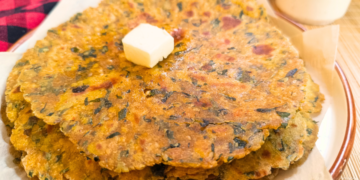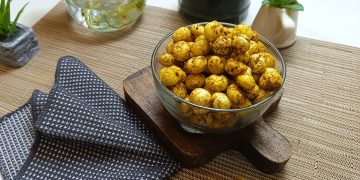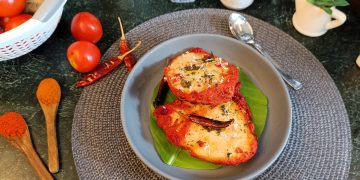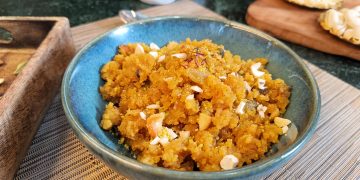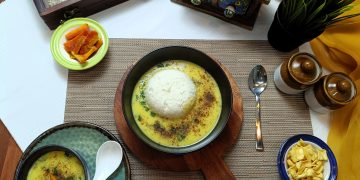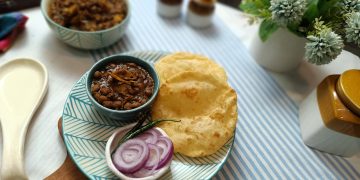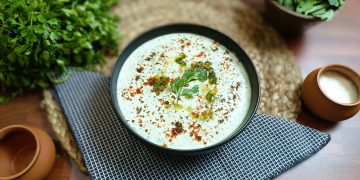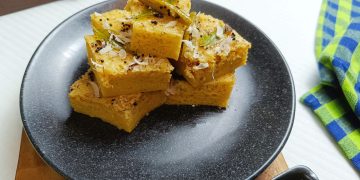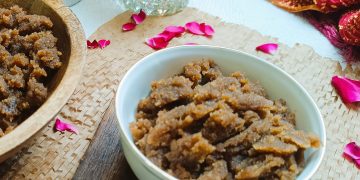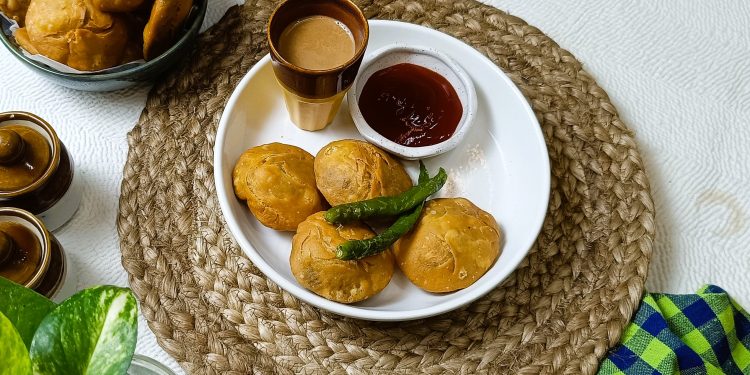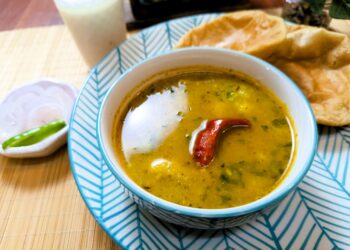Kachori is a popular North Indian and Rajasthani deep-fried pastry, known for its flaky, crispy shell and flavorful, spiced fillings. It’s often enjoyed as a snack or breakfast item, especially in cities like Jaipur, Delhi, and Kolkata, where kachoris are widely available at street stalls, cafes, and sweet shops.
It comes in many varieties, typically named after their fillings, each with distinct regional flavors. Such as: Dal Kachori, filled with spiced lentils (usually urad dal or moong dal), Pyaaz Kachori, popular in Rajasthan,filled with spiced onions, Matar Kachori, this variety uses green peas, adding a slight sweetness and freshness to the filling and Raj Kachori, a larger, chaat-style version, this kachori is hollow and filled with yogurt, chutneys, and other toppings.
Most of the time, Kachoris are loved for their khasta (crispy and flaky) crust, made with flour and ghee or oil. The pastry is deep-fried until golden, creating layers that crumble delightfully when bitten into. The fillings are usually seasoned with spices like cumin, fennel, and garam masala, which give each type its distinctive taste.
What Makes Kachori So Popular?
Kachori stands out for its versatility. It comes in an array of varieties and flavors, each one unique to the region it’s from. Here’s why this crispy treat has become a mainstay in Indian cuisine:
1. Various Flavors and Fillings
Kachoris are traditionally filled with spiced lentils, but the fillings vary widely across regions. In Rajasthan, Pyaaz (onion) Kachori and Mawa Kachori are popular; in Uttar Pradesh, Aloo Kachori steals the show, while in Delhi, Moong Dal Kachori is a favorite. Each filling is distinct, drawing from local ingredients and spices, making Kachori both an adaptable and deeply rooted culinary delight.
2. Perfect Snack for Any Time of Day
Whether for breakfast, as a midday snack, or even dinner, Kachori is welcomed any time. Paired with tangy tamarind or mint chutney, Kachori brings a burst of flavors, making it suitable for every mood and occasion. Its versatility also means that it pairs wonderfully with various accompaniments, from simple yogurt to spicy potato curries.
3. Affordable and Accessible
Kachoris are an affordable snack enjoyed by people from all walks of life. Street vendors, who expertly make them in massive batches, ensure that this beloved snack is within reach, catering to the masses. Kachori is an equalizer in a way – a snack enjoyed by office-goers, students, and food enthusiasts alike.
4. Traditional and Festive Special
In several parts of India, Kachori holds a place in festive celebrations and traditional meals. Special occasions like weddings, Holi, and Diwali are incomplete without a platter of freshly made Kachori. Particularly in Rajasthan and parts of North India, it’s common to see families gather in the kitchen to make Kachoris during festivals, creating cherished memories along the way.
Therefore, Kachoris have a special place in the hearts of snack lovers across India, especially in states like Rajasthan, Uttar Pradesh, and Madhya Pradesh. Often a breakfast or evening snack, this crispy treat is popular at street stalls, served hot with a variety of chutneys. Khasta Dal Kachori stands out for its unique filling, made with spiced urad dal (split black gram) or moong dal (split green gram), which provides a deliciously savory flavor and hearty texture. From home kitchens to bustling markets, kachoris have carved a niche in Indian cuisine and have even spread to international food scenes.
About the Recipe:
Khasta Dal Kachori, a beloved North Indian snack, is the perfect combination of crunch and flavor. Known for its flaky, crispy crust and a spiced lentil filling, this savory treat is a delight for anyone who enjoys Indian street food. Whether served with spicy green chutney, tangy tamarind sauce, or even a refreshing yogurt topping, this kachori delivers a punch of flavor that’s hard to forget. Its name, “Khasta,” meaning “crispy,” perfectly describes the texture of the golden-brown exterior that’s delicately flaky, while the flavorful filling inside completes the experience.
The outer crust is prepared from refined flour, combined with a touch of ghee to achieve that flakiness. The filling is made by soaking, grinding, and then spicing up lentils with cumin, fennel seeds, asafoetida, and an array of aromatic Indian spices. The dough is rolled out, stuffed with the spiced dal mixture, and then deep-fried until perfectly crispy.
Watch how I make the perfect Khasta Dal Kachori with a spiced lentil filling that’ll leave you wanting more!
Ingredients:
Achieving the perfect Khasta Kachori requires just the right blend of ingredients that gives this snack its distinctive texture and irresistible flavor. Here’s a list of each ingredient used in crafting these deliciously flaky kachoris:
All-Purpose Flour (Maida):
The base ingredient for the kachori dough, maida, provides structure to the outer crust, allowing it to be light and flaky. The high gluten content in maida makes the dough stretchable and creates a tender crust once fried.
Ghee or Oil:
Ghee (clarified butter) is traditionally used to enrich the dough, adding a unique depth of flavor and an indulgent touch. It’s also responsible for making the crust perfectly crisp and layered. For a lighter version, oil can be used, but ghee gives an unmatched taste and aroma. Mixing the fat into the flour until it resembles breadcrumbs is crucial for achieving that characteristic flakiness.
Besan or Gram flour:
Using besan (gram flour) in kachori can add a unique layer of flavor and enhance the texture of the filling. Toasting a small amount of besan and mixing it with spices like cumin, coriander, red chili powder, and a pinch of asafoetida can create a fragrant base. It adds a mild nutty flavor and thickens the filling, especially if you’re using ingredients like onions, potatoes, or lentils.
Urad Dal or Moong Dal:
Urad Dal (Split Black Gram) and Moong Dal (Split Green Gram) are commonly used for the filling. Soaking the dal softens it, making it easier to grind and mix with spices. Each dal has a slightly different texture and flavor; urad dal is richer and creamier, while moong dal has a lighter, nuttier taste, letting the spices shine.
Spices:
Fennel Seeds: Adds a hint of sweetness and a refreshing, aromatic note, balancing the heaviness of the dal.
Asafoetida (Hing): Known for its strong aroma, hing adds a unique depth and digestibility to the kachori, enhancing the other spices.
Black Salt: Adds a unique, slightly sulfurous flavor that enhances the savory filling. It has a tangy note that gives the kachori a complex taste, making it more memorable.
Roasted Cumin Powder: Roasted cumin powder has a warm, earthy, and smoky flavor that adds depth to the filling. It complements the nuttiness of besan or dal in the filling and gives an aromatic base to the spices.
Coriander Powder: Ground coriander seeds bring a mild, citrusy note, adding freshness and balancing the earthiness of the cumin. Coriander powder also pairs well with green chili and ginger if used in the filling, enhancing the overall flavor complexity.
Red Chili Powder: Red chili powder gives the filling a spicy kick, which can be adjusted according to preference. It adds a vibrant color to the mixture and a slight heat that balances the tangy and savory notes.
Turmeric Powder: Turmeric adds a warm, golden hue to the filling and contributes a subtle earthy flavor. It also has an anti-inflammatory quality, giving the filling an authentic Indian touch with health benefits.
Amchur (Dried Mango Powder): Amchur powder provides a tangy, fruity flavor that brightens up the filling. It’s particularly good for balancing the richness of the fried kachori crust with a bit of acidity.
Salt to Taste: Regular salt enhances all the flavors, and balancing it with black salt creates layers of taste, making each bite exciting and flavorful.
Kasuri Methi (Dried Fenugreek Leaves): Kasuri methi has a slightly bitter, aromatic quality that adds a distinct flavor. Its subtle bitterness enhances the spices without overwhelming the filling, making the kachori taste richer and more fragrant.
Each ingredient plays an important role in creating the perfect Khasta Kachori, resulting in a snack that is crispy, flaky, and filled with an explosion of flavor in every bite. With these ingredients, you’re set to create kachoris that rival those from your favorite street vendor!
Serving Suggestions:
Khasta Dal Kachori is a beloved Indian snack known for its flaky, crunchy crust and savory, spiced filling. To elevate the flavors, serve it with a variety of sides and accompaniments that balance its richness and enhance its taste.
Aloo Sabzi (Potato Curry): In North India, kachoris are commonly paired with a spicy, flavorful potato curry. The tender, spiced potatoes are a classic side that soaks up the kachori’s filling, creating a comforting, wholesome combination. The curry is often garnished with fresh coriander and sometimes even green chilies for extra heat, giving you a burst of flavor with each bite.Green Chutney:
This vibrant, herb-packed chutney made from fresh coriander, mint, green chilies, and a hint of lemon juice adds a refreshing, spicy kick to the kachori. The zesty flavors cut through the richness of the fried crust and complement the warm spices in the filling.
Tamarind Chutney: Tamarind chutney, made with tamarind pulp, jaggery, and a pinch of roasted cumin powder, brings a tangy, slightly sweet contrast to the kachori. The sweetness and acidity balance the spiciness and add a mouthwatering depth of flavor to each bite.
Yogurt (Dahi): A dollop of thick, creamy yogurt is the perfect way to mellow out the heat and spice from the kachori and chutneys. The coolness and slight tang of yogurt add a soothing balance, bringing a creamy texture that enhances the crispy, flaky kachori crust. Some even add a sprinkle of chaat masala, cumin powder, and fresh coriander to the yogurt for extra flavor.
For a complete street-style experience, you can serve the kachori with a drizzle of both chutneys and a spoonful of yogurt, topped with sev or crushed papdi for crunch. With these accompaniments, your Khasta Dal Kachori becomes a flavorful, multi-textured snack that’s truly satisfying!
Variations:
Kachoris are incredibly versatile, and with just a few changes to the filling or cooking method, you can enjoy a variety of flavors and styles. Here are some popular and delicious variations to try:
Onion Kachori:
For a flavorful twist, replace the dal filling with a spiced onion mixture. To make it, sauté finely chopped onions with cumin, coriander powder, red chili powder, and a pinch of garam masala. This creates a sweet and savory filling that adds depth to the kachori. Onion kachoris are especially popular in Rajasthan, known for their slightly caramelized, spicy filling that pairs perfectly with tangy chutneys.
Matar Kachori:
For a fresh, subtly sweet filling, use green peas (matar) instead of dal. Lightly mash the peas and cook them with spices like cumin, coriander powder, green chilies, and a touch of ginger. The peas lend a vibrant green color and a delicate sweetness that complements the flaky kachori crust. Matar kachoris are particularly popular during the winter when fresh green peas are in season.
Masala Kachori Chaat:
Turn leftover kachoris into a flavorful chaat by breaking them into pieces and topping with creamy yogurt, tangy tamarind chutney, spicy green chutney, and a sprinkle of chaat masala. Add sev, chopped onions, and fresh coriander for a crunchy, colorful garnish. This chaat variation is a crowd-pleaser and brings together multiple textures and flavors in one delightful dish.
Baked Kachori:
For a healthier alternative, skip the frying and bake the kachoris instead. Preheat the oven to a high temperature (around 400°F/200°C), brush the kachoris with a little oil or ghee, and bake until golden and crisp, about 15-20 minutes. While they may not be quite as flaky as the fried version, baked kachoris still retain the delicious flavors and make for a lighter snack that’s perfect for those watching their calorie intake.
These variations allow you to enjoy kachoris in different forms, whether as a classic street food snack, a chaat, or even a healthier baked option. Each brings a unique twist to this beloved snack, letting you explore and enjoy new flavors with every bite!
Thus, Kachori, with its flaky crust and richly spiced filling, has become more than just a snack—it’s a cultural favorite that brings people together across India. Whether enjoyed as a street food treat with spicy chutneys, transformed into a satisfying chaat, or baked for a healthier twist, kachoris offer a versatile and indulgent experience. With endless variations like Onion Kachori, Matar Kachori, and even fusion adaptations, this beloved snack captures the heart of Indian flavors and continues to evolve in exciting ways. Making kachori at home allows for creativity, experimentation with fillings, and the pleasure of savoring each crispy, flavorful bite. So, gather your favorite spices, create your own twist, and delight in this timeless snack that celebrates the art of Indian cooking.
Print
Khasta Dal Kachori
- Total Time: 1 hour 10 minutes
- Yield: 15-16
Description
Khasta Dal Kachori is a beloved North Indian snack, crispy, golden kachoris filled with spiced gram flour and aromatic spices. This kachori recipe is easy to make at home and is perfect for festive gatherings, tea-time indulgence, or satisfying any savory craving. Follow our step-by-step guide to create these Khasta Dal Kachori at home and enjoy their irresistible taste.
Ingredients
For the Filling:
-
2 tbsp oil
-
1 tsp fennel seeds (saunf)
-
¼ cup gram flour (besan)
-
½ cup urad dal (soaked overnight and drained)
-
1 tsp black salt powder
-
½ tsp roasted cumin powder
-
1 tbsp coriander powder
-
1 tsp red chili powder
-
½ tsp turmeric powder
-
1 tsp dry mango powder (amchur)
-
Salt to taste
-
½ tsp dried fenugreek leaves (kasuri methi)
-
¼ tsp asafetida (hing), dissolved in water
-
¼ tsp baking soda
For the Dough:
-
2 cups all-purpose flour (maida)
-
50 grams ghee (approx. ¼ cup)
-
Warm water, as needed
For Frying:
-
Oil
Instructions
Prepare the Filling
- In a pan, heat 2 tablespoons of oil over medium heat.
- Add the fennel seeds, letting them sizzle and release their aroma for a few seconds.
- Add the gram flour (besan) and sauté, stirring continuously until it turns golden brown and gives off a nutty aroma. This will take about 2-3 minutes.
- Add the drained urad dal to the pan and mix well, ensuring the besan and dal are combined thoroughly. Cook, stirring frequently, until the mixture turns a slightly deeper color, about 3-4 minutes.
- Add black salt powder, roasted cumin powder, coriander powder, red chili powder, turmeric powder, dry mango powder, and salt to taste.
- Continue to cook the filling mixture, stirring constantly, until the spices are well mixed and the mixture becomes aromatic and slightly dry in texture.
- Then, add kasuri methi.
- Mix well and add asafetida dissolved in water.
- Stir well for a few seconds.
- Turn off the flame.
- Remove the pan from heat, transfer the filling to a plate, and let it cool. Add a bit more kasuri methi if desired, and then mix in the baking soda to give the filling a light and airy texture.
- Once the mixture has cooled, shape it into small balls using about 1.5 tablespoons of filling for each. Set the balls aside to use later in the kachori.
Prepare the Dough
- In a large mixing bowl, add the all-purpose flour, and ghee. Rub the ghee into the flour with your fingers until the mixture resembles coarse crumbs.
- Gradually add warm water, a little at a time, to form a soft and smooth dough.
- On a wooden board or flat surface, tap the dough with some force at least 15-20 times. This step helps make the dough smoother and more flexible, which results in a better texture.
Assemble the Kachoris
- Divide it into small equal-sized pieces, roughly the size of a golf ball.
- Take one dough ball, flatten it gently with your fingers, and place one of the filling balls in the center. Bring the edges of the dough together, sealing it completely at the top. Gently flatten the filled ball into a thick disc.
- Repeat this process with the remaining dough balls and filling to make all the kachoris.
Fry the Kachoris
- In a deep frying pan or kadhai, heat oil over medium heat.
- Once the oil is hot, reduce the flame to medium-low. Gently slide the kachoris into the oil, being careful not to overcrowd the pan. Fry the kachoris slowly, turning them occasionally, until they are evenly golden brown and crispy on all sides. This slow frying process takes about 20-25 minutes per batch, ensuring the kachoris are perfectly crisp.
- Remove the fried kachoris from the oil and place them on a paper towel to absorb any excess oil.
Serve these khasta kachoris hot with your favorite chutney and some fried green chilies on the side. Enjoy the crispy, flaky layers with the spicy filling!
Notes
- For an extra burst of flavor, consider roasting the fennel seeds, cumin powder, and coriander powder lightly before adding them to the filling. This will intensify their aroma.
- When sautéing the gram flour (besan), be sure to stir continuously to prevent burning. The flour should turn golden and release a nutty aroma. Sautéing properly ensures the flour doesn’t taste raw in the filling.
- After adding the drained urad dal to the gram flour mixture, cook until the mixture turns a slightly deeper shade. This helps develop a rich flavor. Make sure the dal and besan are fully combined before adding spices.
- Crush the dried kasuri methi leaves between your palms before adding them to the filling. This helps release more flavor, giving the kachori a signature aroma. Add a bit more after cooking for a stronger flavor if desired.
- Ensure the filling cools completely before shaping it into balls. Warm filling can make the dough soggy, leading to potential breakage during frying.
- Take time to rub the ghee into the flour until the mixture resembles coarse crumbs. This step is crucial for achieving the flaky, crispy texture of khasta kachoris. It ensures that the ghee is evenly distributed and helps create layers.
- Add warm water little by little, as too much water can make the dough sticky and hard to manage. The dough should be soft yet firm enough to hold its shape without sticking to your hands.
- After kneading, firmly tap the dough on a wooden surface 15-20 times. This trick is helpful for developing gluten in the dough, making it smoother and more elastic. It also helps achieve that flaky texture.
- Let the dough rest for at least 10-15 minutes under a damp cloth. Resting makes the dough more pliable and easier to work with, which prevents it from breaking during filling and frying.
- While wrapping the dough around the filling, make sure the edges are sealed well. A loose seal may cause the filling to leak out while frying, making the kachori greasy.
- Add only 1.5 tablespoons of filling per dough ball. Overfilling can cause the kachori to burst while frying. If unsure, err on the side of less filling until you get comfortable with the process.
- When pressing the filled dough into a disc, do it gently to avoid tearing the dough. Lightly press with your palms or fingertips to maintain the seal and shape.
- Start frying at medium heat, then reduce to medium-low. If the oil is too hot, the kachoris will brown quickly on the outside while remaining uncooked inside. To test, drop a small piece of dough in the oil—it should sizzle and float slowly.
- Fry the kachoris slowly, turning them occasionally for even cooking. This slow frying (about 20-25 minutes) is key for achieving the crisp, flaky texture and golden color.
- After frying, drain the kachoris on paper towels to absorb any excess oil. This keeps them light and non-greasy.
- If you need to reheat the kachoris later, use an oven at low heat to maintain their crispness instead of a microwave, which can make them soft.
- Serve the khasta kachoris hot with tangy tamarind chutney, spicy green chutney, and fried green chilies. They’re best enjoyed fresh, showcasing their crispy, flaky texture alongside the rich, spiced filling.
- Prep Time: 25 minutes
- Cook Time: 45 minutes
- Category: Snacks, Appetizer
- Cuisine: Indian

